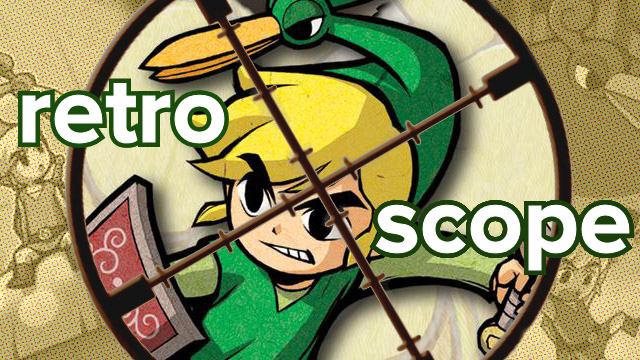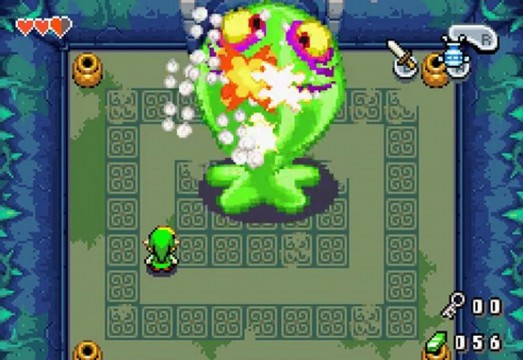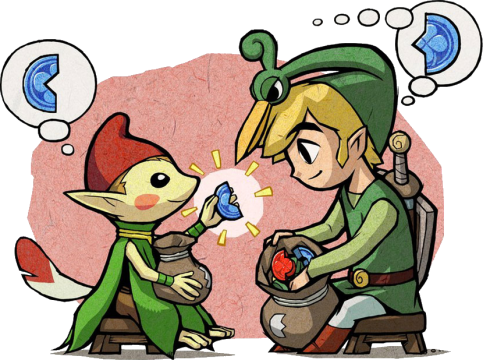
Recently, I picked up The Legend of Zelda: Hyrule Historia from Dark Horse Comics. If you haven’t read it, it’s a must have for any Zelda fan. Feeling nostalgic, and a little bit guilty for not getting too far in Skyward Sword, I decided to try out a Zelda game that I received as part of the 3DS’ ambassador program: The Legend of Zelda: The Minish Cap. While Zelda games tend to be highly regarded, The Minish Cap is one that I’ve never heard all that much about, which only piqued my curiosity more. What I found is a game that deserves to be held in much higher regard.
The game starts out with a sorcerer named Vaati invading the kingdom of Hyrule while searching for the mythical Light Force. After shattering the Picori Blade, he unleashes monsters on the land of Hyrule before turning the game’s titular princess to stone. Knowing that only the Picori Blade can stop Vaati and that only children can see the long lost Picori race, the king enlists Zelda’s childhood friend, Link, to rescue his daughter. Along his journey, Link encounters a talking hat by the name of Ezlo, who grants him the ability to shrink to the height of the Picori, and the two set off on a quest to fix the blade, save Zelda and rid Hyrule of Vaati’s evil.
The Minish Cap is a bit of an odd Zelda title. For starters, it deviates quite a bit from more traditional Zelda games. When the game came out in early 2005, there were very few games in the series not to feature Ganon or the Triforce. Instead, the game provided us with origins and backgrounds for Vaati and the Four Sword, neither of which had ever really been fleshed out when they first appeared in earlier Zelda titles. While the Zelda series has recently started to steer towards new villains and stories, The Minish Cap can be viewed as one of the earliest examples of this. The game has the same 2D top-down Zelda core we’ve seen since the ’80s, but it brings in a lot of new ideas that make it feel fresh at the same time.
The game’s focus on the ability to shrink and grow to solve puzzles and defeat bosses adds a unique wrinkle to the gameplay. While Zelda fans have always been hesitant to embrace “gimmicks” (such as Link’s ability to turn into a wolf in Twilight Princess), I enjoyed the way that puzzles required you to switch back and forth between different heights. The game’s design takes full advantage of this, as Link must ride on leaves to cross small ponds, and sometimes minor enemies like the Chuchu become boss battles when Link is smaller.

This also brings us to the game’s art design. The Minish Cap is a really sharp looking game, and the whole world is really complemented by the perspective we see when Link is shrank down. While the land of Hyrule doesn’t look all that different from what we’ve seen in other 2D Zelda games, the world gets a neat makeover when we see it from a Picori perspective. The guys at Capcom did a wonderful job of designing the Minish Village and other smaller areas that Link must navigate. I also really liked the design of Ezlo. He’s probably the best “sidekick” Link has ever had, and I’d love to see him pop up again sometime. Unlike Navi, you won’t be sick of him by the end of the game.
The game’s music is probably some of the best to come out of a Game Boy Advance title as well. Familiar Zelda songs and sounds are breathtakingly recreated. My only recommendation is that you use a pair of headphones. The Game Boy Advance’s speakers (and the 3DS’s) just don’t do the music the same amount of justice.
That’s not to say the game is without its shortcomings (no pun intended). Many die-hard Zelda fans have found that the game length leaves a bit to be desired as The Minish Cap only features six dungeons in total. While I found this to be ideal for the handheld format, I can see why some Zelda purists would be turned off by it. Some of the game’s puzzles can also be really, really hard to solve. There were more than a few times that I had to hunker down, look at the map and troubleshoot an area with just about every tool at my disposal.

The game also introduces a system called Kinstone Fusion. Throughout the game, players will find items known as Kinstones, which look like a medal broken in half. By combining these Kinstones with other NPCs, “something good will happen,” as the game vaguely puts it. This results in rupees and hearts showing up in random places throughout Hyrule and, sometimes, even major puzzles being solved. The problem is, Kinstone Fusion almost feels a little too forced in those puzzles. Instead of feeling natural, like using the Gust Jar to push your leaf raft across a pond, it feels like the game could have made you do just about anything in these scenarios.
Another problem is that The Legend of Zelda: The Minish Cap will KILL your hands towards the end of the game. While I never had too much difficulty with extended play, the final boss battle left my hands and thumbs aching. After dying on my first couple of tries, I actually decided to throw on a movie so I could rest my hands for a while before I went back and finished off the game.
While The Legend of Zelda: The Minish Cap will never be as highly regarded as series titles like Ocarina of Time or A Link to the Past, it’s certainly one of the more underrated games to bear the Zelda name. There’s an undeniable charm to the Picori people, Ezlo and just about everything else unique to the game. It also added new concepts to the series and provided us with the origins of both Vaati and the Four Sword. Fans of the Zelda series would do well to give the little guy a chance if they haven’t already.




 ShareThis
ShareThis







I also play this game for the first time last year and i also got it from the embassador program, i really like this game, it took me 22 hours to beat, its colorful, charming and well made, i tried to collect all the kingstones but ultimately it was a waste of time. It is to date te only 2d zelda i have ever played and altough its full of charm i think i prefer the 3d versions.